
How to look for records of... Census records
How can I view the records covered in this guide?
How many are online?
- All
Contents
- 1. Why use this guide?
- 2. What is the census and why was it compiled?
- 3. How the census was taken and on what dates
- 4. Where to access and how to search the censuses
- 5. People in the census
- 6. Places in the census
- 7. Addresses, houses and other buildings in the census
- 8. Ships and institutions in the census
- 9. Common census terms and abbreviations
- 10. Why can't I find my ancestor in the census?
- 11. The National Archives references for censuses
- 12. Censuses for Scotland and Ireland
- 13. British colonies and protectorates
- 14. Other useful online resources
- 15. Further reading
1. Why use this guide?
This guide explains how to access the historical censuses from 1841 to 1921 and provides information on using the census returns of:
- England
- Wales
- the Channel Islands
- the Isle of Man
- vessels in English and Welsh ports and inland waterways from 1861 onwards
- the British Army overseas (1911 and 1921 only)
- RAF bases overseas (1921 only)
All later censuses remain in the custody of the Office for National Statistics. They will remain closed to the public for 100 years after the date they were conducted.
Read section 12 for information on the census returns for Scotland and Ireland.
The 1939 Register is similar to but not the same as the census. For more information on the 1939 Register, please read the guide on the 1939 Register.
2. What is the census and why was it compiled?
The census is a head count of everyone in the country on a given day. A census has been taken in England and Wales, and separately for Scotland, every ten years since 1801, with the exception of 1941.
The object of the census was not to obtain detailed information about individuals, but to provide information about the population as a whole; listing everyone by name, wherever they happened to be on a single night, was the most efficient way to count everybody once, and nobody twice.
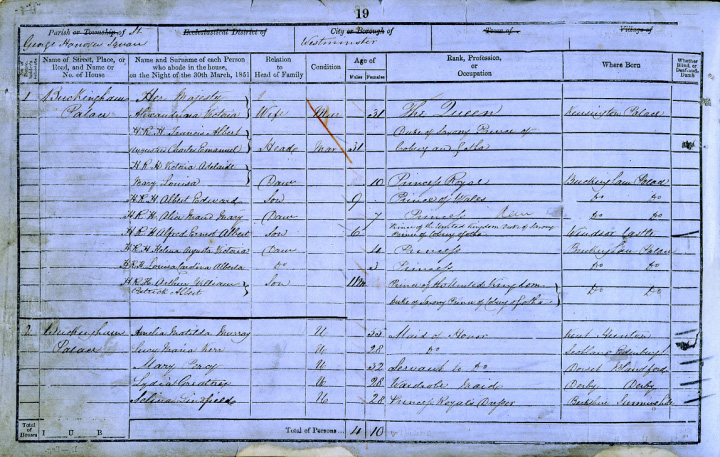
A page from the 1851 census. This page, from the enumeration books, shows part of the head count at Buckingham Palace (catalogue reference HO 107/1478).
3. How the census was taken and on what dates
In every census year an enumerator delivered a form to each household in the country for them to complete. The heads of household were instructed to give details of everyone who slept in that dwelling on census night, which was always a Sunday. The forms completed by each household, known as schedules, were collected a few days later by the enumerator. From 1841 to 1901 the information from the schedules was then copied into enumeration books. Once the enumeration books had been completed, most household schedules were destroyed, although there are some rare survivals. It is the enumeration books that we consult today online or on microfilm.
The 1841 census was the first to list the names of every individual, which makes it the earliest useful census for family historians. However, less information was collected in 1841 than in later census years. Read section 5 for details of the information recorded in each census year.
The General Register Office was responsible for taking the census, so it used the administrative framework already in place for the registration of births, marriages and deaths. The Superintendent Registrar was responsible for collecting the returns from each Registrar of Births and Deaths in their registration district, and sending them to the Census Office in London. Each Registrar of Births and Deaths was responsible for a sub-district, which they divided into enumeration districts (EDs), and recruited enumerators for each ED.
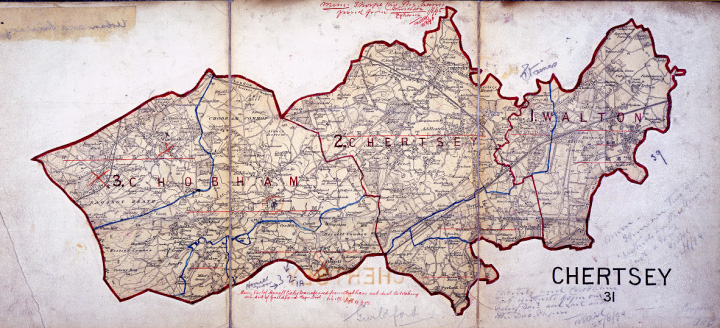
This map illustrates three of the registration sub-districts at the time of the 1891 census. The map was annotated for use by the registrars responsible for collecting the census returns for this district (catalogue reference RG 18/229).
The dates of the censuses were as follows:
- 1841 – 6 June
- 1851 – 30 March
- 1861 – 7 April
- 1871 – 2 April
- 1881 – 3 April
- 1891 – 5 April
- 1901 – 31 March
- 1911 – 2 April
- 1921 – 19 June
The intended date for the 1921 census was 24 April, but was postponed due to industrial unrest, which the GRO decided would have made it impossible to collect accurate information in some areas.
In the censuses of 1801, 1811, 1821 and 1831 lists of names were not collected centrally, although some are held in local record offices. Other lists were sometimes compiled, for a variety of reasons, which are often referred to as census ‘substitutes’. Read Local Census Listings or Pre-1841 Censuses and Population Listings in the British Isles for more information. Some transcripts and images for these early censuses and census substitutes are searchable online on Findmypast.co.uk, Ancestry.co.uk and the Brigham Young University Early British Census Project.
4. Where to access and how to search the censuses
4.1 Where to access the censuses
The censuses from 1841 to 1921 are available online. Links to our official partner websites, Ancestry and Findmypast, for each census (£) are listed in the table below. Images and indexes for all censuses from 1841 to 1911 are available on both of these sites, and on a number of other commercial websites (£).
It is free to search on these sites, but there is a charge to view full search results and digitised images. However, you can view censuses from 1841 to 1921 free of charge on site at The National Archives in Kew, and from 1841 to 1911 at many libraries and record offices and at FamilySearch Centres worldwide. The 1921 Census is also free to view via Findmypast at the Manchester Central Library, on St Peter’s Square, Manchester, supported by the Manchester and Lancashire Family History Society helpdesk and the Archives+ Team, and at the National Library of Wales, in Aberystwyth.
Many local and county record offices also hold microfilm or microfiche copies of the census returns for their own area, excluding 1911 and 1921. Use Find an archive to find contact details for local and county record offices.
Read section 12 for information on the census returns for Scotland and Ireland.
| Census year | Online version of censuses for… | Provided by |
|---|---|---|
| 1921 | England, Wales, Channel Islands and Isle of Man | Findmypast.co.uk |
| 1911 | England, Wales, Channel Islands and Isle of Man | Findmypast.co.uk |
| 1901 | England, Wales, Channel Islands and Isle of Man | Findmypast.co.uk |
| 1891 | England, Wales, Channel Islands, Isle of Man | Ancestry.co.uk |
| 1881 | England, Wales, Channel Islands, Isle of Man | Ancestry.co.uk |
| 1871 | England, Wales, Channel Islands, Isle of Man | Ancestry.co.uk |
| 1861 | England, Wales, Channel Islands, Isle of Man | Ancestry.co.uk |
| 1851 | England, Wales, Channel Islands, Isle of Man | Ancestry.co.uk |
| 1841 | England, Wales, Channel Islands, Isle of Man | Ancestry.co.uk |
There are free indexes to all of the census returns up to 1911 at FamilySearch.org, with links to the images on Findmypast (£). You can also search census returns for England and Wales on Findmypast (£).
Some transcripts of census records covering England, Wales and Scotland are available free of charge on FreeCEN.org.uk. Statistics on coverage are listed, by county, on their website.
4.2 How to search the censuses
You can search by name, browse by place, or locate an exact page if you have the full census reference. Read section 11 for information on using census references. Depending on the census year, and the site, other search options may be available.
Street indexes were created for districts containing towns with a population of around 40,000 or more, from 1841 to 1901. Online versions for the street indexes for 1841, 1851, 1861, 1871 and 1891 are preserved in the UK Government Web Archive. Please note that the limitations of the software that captures website content means that some links within archived web pages do not work. Printed copies of the 1841, 1881 and 1901 street indexes are available in the reading rooms at The National Archives. For 1871 census registration district maps see Cassinimaps.co.uk (£).
4.3 Post-1911 censuses
Unlike earlier censuses, the 1921 census (and later censuses) are subject to the Census Act 1920, as amended by the Census (Confidentiality) Act 1991 c.6 which makes it an offence to disclose personal information held in them until 100 years after the date they were conducted. Until then, they are held by the Office for National Statistics. Statistical information from these censuses is openly available.
Unfortunately, the 1931 census for England and Wales was destroyed by fire in 1942, and no census was taken in 1941 because of the Second World War.
5. People in the census
The following information on individuals enumerated within households is included in each census year as follows (slightly different questions were asked on schedules for institutions and vessels, depending on the location and census year):
1841
- first name and surname
- age (rounded down to the nearest five years for those aged 15 or over)
- sex
- occupation
- whether they were born in the county where they were enumerated (Y or N)
- whether they were born in Scotland (S), Ireland (I) or Foreign Parts (P)
1851 and 1861
- first name, middle names (often just initials) and surname
- relationship to the head of the household
- marital status
- age (at last birthday)
- sex
- rank, profession or occupation
- where born – county and parish if born in England or Wales, country only if born outside England and Wales)
- whether blind, or deaf and dumb
1871 and 1881
As 1851 and 1861, except for the following difference:
- the last column now reads: 1. Blind 2. Deaf and Dumb 3. Imbecile or Idiot 4. Lunatic
1891
As 1871 and 1881 with the following extra details on employment:
- whether Employer, Employed, or Neither Employer nor Employed
- language spoken (Wales only)
1901
As 1891, with occupation details changed to:
- ‘Employer, Worker or Own account’
- a new column ‘If working at home’
- language spoken (Isle of Man only)
1911
As 1901, with extra questions:
- For married women only, the number of years of their present marriage, the number of children born of that marriage, the number still living, and the number that had died.
- As well as their occupation, the industry in which the person was employed. If employed by a government, municipal or other public body, the name of that body.
- Parish and county of birth for anyone born in the UK (which included all of Ireland). If born elsewhere in the British Empire, the colony or dependency, and the state or province.
- For anyone born outside England and Wales, whether they were resident or visitor in the country.
- Nationality of anyone born overseas whether British by parentage, British by naturalisation (including year of naturalisation) or, if a foreign national, of which country.
- In the Infirmity column, the age at which the person had become afflicted.
In 1911 all the household schedules were kept, for the first time (see RG 14), and were not copied into enumeration books. There are instead enumerators’ summary books which list every address, including unoccupied buildings, and the only names they contain are those of the head of each household (see RG 78). These summary books are the only place you will find a description of each building such as ‘House and shop’, ‘Hotel’, ‘Private house’. Unoccupied houses and non-residential properties such as churches and factories are also listed.
1921
This was the first census where old questions were dropped, as well as new ones being added. The questions about the length of present marriage, and the number of children born within it, were no longer included. For the first time since 1841, there was no longer a question on infirmity or disability.
There were also changes to some existing questions:
- Age was asked for in years and months, not just in years
- ‘Divorced’ was added as an option for marital status
- Name and business of each person’s employer (in 1911 this was only required from those in public service), and the address of their place of work. ‘No fixed place’ was added as an option, in addition to ‘Home’
- For persons born outside the United Kingdom, country and state or province of birth; state or province was previously asked only of those born in the British Empire. Naturalised British subjects were no longer asked for their year of naturalisation
New questions were added:
- For children under 15, whether both parents were alive, father dead, mother dead, or both dead
- Whether in full-time or part-time education
- Married men, widows and widowers were asked for the number and ages of their living children and step-children under 16
In 1921 there are household schedules, as in 1911, but there are no enumerators’ summary books as there are for 1911. Instead, there are ‘Plans of Division’ which describe the boundaries and contents of each enumeration district.
6. Places in the census
The first page of each enumeration book contains a description of the area covered. In the earlier years the amount of detail varies; they could contain a list of streets, and describe the route taken by the enumerator, but in rural areas the description might simply read ‘The whole of the parish of …’. From 1891 onwards there are separate sections for a description of the boundaries of the ED, and for a list of the streets or dwellings included.
In 1911 these details are in the Enumerators’ Summary Books, and in 1921 they are in the Plans of Division.
7. Addresses, houses and other buildings in the census
Exact addresses were not required in 1841, only ‘place’. From 1851 an exact address was required, including the house name or number, if any. However, in rural areas the only information given still might be the name of the village or parish. Numbers in the left-hand column are schedule numbers, and should not be mistaken for house numbers.
A note was made of buildings that were uninhabited, or under construction, in every census year. In 1891 and 1901 the number of rooms in a dwelling was listed, if fewer than five. In 1911 and 1921 the number of rooms is shown on all household schedules, and other information is in the Enumerators’ Summary Books, described in section 5, above, for 1911 only.
From 1851 to 1901 a census entry for a new household is indicated by a new schedule number. In all census years except 1851, 1911 and 1921 the last entry in a building is indicated by a double oblique line //, and where there is more than one household within a building, they are separated by a single oblique line /. In 1851 a line is ruled across the page at the end of a building, or half-way across the page between households within a building.
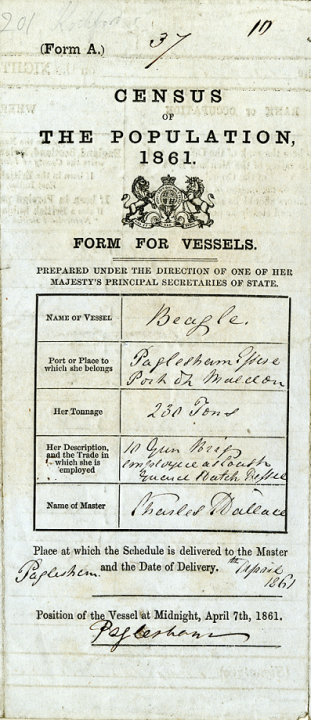
Example of a census form for vessels. This one was used for the 1861 census to record the crew of the HMS Beagle (catalogue reference RG 9/1085).
8. Ships and institutions in the census
Special enumeration books were completed for institutions such as workhouses, barracks and hospitals in every census year from 1851, including 1911. Special schedules for vessels were introduced in 1851, although none are known to survive from that year, so in practice 1861 was the first year to include returns from the Royal Navy and merchant shipping, at sea and in ports at home and abroad. Due to the difficulties of collecting enumeration books from ships in distant ports, shipping returns are likely to be incomplete.
In 1861 all returns from the Royal Navy and from merchant vessels are at the end of the series, but after that vessels in home ports are listed at the end of the districts where they were moored, and only those in foreign waters are grouped together at the end of the series.
There are no surviving records for Royal Navy ships in foreign waters in 1891. It is not known what happened to these records.
In 1901 Royal Navy ships in foreign waters are listed alphabetically, and there are no returns for ships between HMS Amphion and HMS High Flyer. However, a duplicate copy of the enumeration of HMS Cygnet in 1901 was sent to the General Register Office by the Admiralty and is included in RG 19/20.
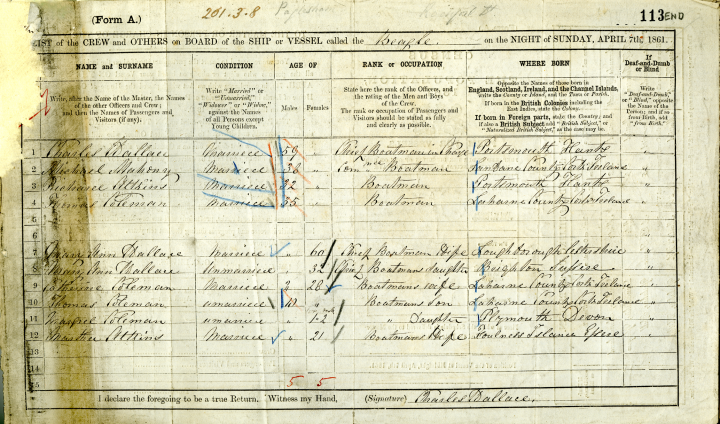
The completed census form recording the crew of the HMS Beagle (catalogue reference RG 9/1085).
1911 was the first census where the British Army overseas was enumerated; previously there was only a headcount. This also applies in 1921, with the addition of Royal Air Force bases overseas.
9. Common census terms and abbreviations
In addition to the terms and abbreviations described below, section 5 and section 7 of this guide describe other conventions used in the censuses.
Relationships (from 1851)
In practice, the head of the household was often the oldest male, but not necessarily. Everyone else, whether wife, son, servant or anyone else, should have been described in relation to this person, but this was not always followed accurately. In three-generation families young children may be shown as ‘son’ or ‘daur’ (daughter) when they are really the grandchildren of the head. ‘Son (or daughter)-in-law’ can mean a stepchild, as well as the husband or wife of the head’s own children. A boarder is someone who resides within the household but is not a relative or servant, while a lodger only rents a room or rooms, but these terms are often used interchangeably.
Relationships are not recorded in most schedules for vessels or institutions. Instead, there may be a question on each person’s rank or position within the vessel or institutions. However, the exact details vary depending on the type of schedule, the year, and the location.
Condition (as to marriage)
Mar or M – married
Unm, Un or U – unmarried (replaced by S for single from 1891)
Wid or W – widowed
D – divorced (1921 only)
‘Divorced’ was not an official category until 1921, and does not feature in the statistical tables, but does appear occasionally in this column in some earlier census years.
Rank, profession or occupation
There were specific instructions on recording extra details for several occupations; notably the professions, the armed forces, public servants and anyone involved in agriculture or manufacturing. Sometimes the clerks in the Census Office altered or expanded these definitions to assign them to one of the categories in the Registrar General’s classification of occupations for that census year.
These are some of the most common terms and abbreviations found in the ‘Rank profession or occupation’ column:
Ag lab – agricultural labourer
Annuitant – living on income from investments
Ap or App – apprentice
FS, MS – used in the 1841 census for ‘female servant’ and ‘male servant’
FWK – also in 1841, for ‘framework knitter’ a common occupation in the East Midlands
Gentleman – Usually denotes someone living on an income from investments, or retired from business, but has no official definition
Ind or Independent – ‘Of independent means’
J – journeyman; someone who had completed an apprenticeship but was not a master with a business and apprentices of their own
Pensioner – usually means an army pensioner; other types of pensioner are generally identified as such, including Greenwich Pensioner (naval pensioner), police pensioner and so on. Old age pensions were introduced in 1908, so the term ‘old age pensioner’ appears for the first time in 1911
10. Why can’t I find my ancestor in the census?
There are many reasons that explain why you might not find somebody in the census. Read our blog post ‘Missing from the census?’ or watch our webinar, also called ‘Missing from the census?’, to discover how information can be missed or altered, as well as to learn tips for more successful searching.
There are some pages missing from all censuses, but 1861 has suffered most.
Missing from 1861 census
You can use The National Archives catalogue to find out which parishes or districts are known to be missing from the 1861 census. Use the keyword ‘missing’ to search within series RG 9 in our catalogue.
Missing from 1841 census: Wrexham
The 1841 census returns for the whole registration district of Wrexham, Denbighshire, were believed to be missing. However, the original enumeration books for the town of Wrexham were discovered in a bookshop, and are now deposited in the Denbighshire Archives. An indexed transcript has been published by the Clwyd Family History Society, and a copy is available at The National Archives.
Missing from other censuses
As with the 1861 census, you can use our catalogue to search the record series for any other census year to find out about whole parishes or districts that are known to be missing, but compared to 1861 there is less detail about odd missing pages. Use section 11 to determine which National Archives record series to search within and search using the word ‘missing’.
For more guidance on how to search our catalogue, read Discovery search help.
11. The National Archives references for censuses
Although most people now access the census online, and not on microfilm, census references are still very useful. Search engines on websites vary, and they can also change over time, but the original National Archives references never change. If you have a full reference, you should be able to use it to find a page on Ancestry.co.uk or on Findmypast.co.uk, even if you have obtained it from a different site, or from some other source. This is particularly useful when a person can be found using a name search on one site, but not on another, due to differences in transcription.
You may find census references quoted in books and articles, and you will also need to know how to use them if you are consulting our online and hard-copy street indexes (see section 4.2).
A census reference has three main elements; a department (letter) code, a series number, and a piece number. The department and series codes for each census year are:
- 1841 and 1851: HO 107
- 1861: RG 9
- 1871: RG 10
- 1881: RG 11
- 1891: RG 12
- 1901: RG 13
- 1911: RG 14
- 1921: RG 15
A piece may contain hundreds of pages, so extra information is required to find the right place within a piece. The census returns for most years follow a single format, but there are slightly different arrangements for 1841, 1911 and 1921.
Census returns from 1851 to 1901
The extra reference is a folio number and (optionally) a page number.
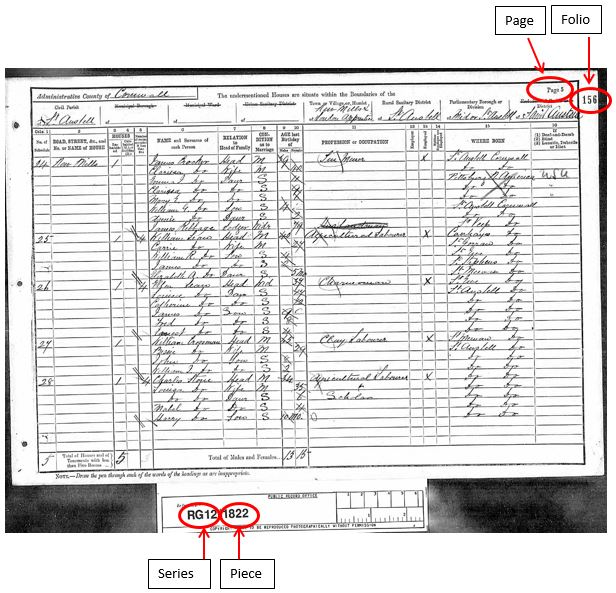
The National Archives reference for this page, from the 1891 census, is RG 12/1822, Folio 156, Page 5.
Each piece contains several enumeration books with numbered pages. Later, folio numbers were stamped on the top right corner of every right-hand page, starting at the beginning of the piece and continuing through all the enumeration books. Since folio numbers appear only on alternate pages, each folio represents the page where it appears and the following page. Therefore a series, piece and folio reference enables you to locate the correct pair of pages but a page number can be added to the reference to identify a single page, if required, as in this example from the 1891 census:
Both Ancestry.co.uk and Findmypast.co.uk offer an exact reference search facility for each census year 1841 – 1901. For 1911, there is an exact reference search on Findmypast only.
The 1841 census
Each piece in 1841 is further divided into books, so a full reference needs to include a book number after the piece number, for example HO 107/1298/8 as it appears on the census image. Each book then contains its own series of folio numbers, which should be included in a full reference, for example, HO 107/1298, book 8, folio 10.
The 1911 and 1921 census
For these census years the household schedules were kept, instead of being copied into enumeration books. Each piece represents an enumeration district (ED). In 1921 some pieces cover two small enumeration districts, so the ED number should be included in a full reference. Instead of folio numbers, each household has a unique schedule number in the top right-hand corner, so that a reference will be in the format RG 14/26288 Sch 227, for 1911, or RG 15/12199, ED 7, Sch 43, for 1921.
Institutions and vessels do not have schedule numbers, instead the information was recorded directly into special enumeration books with numbered pages, as in previous census years.
12. Censuses for Scotland and Ireland
Scotland, 1841-1921
Search and view the census returns for Scotland from 1841 to 1921 at Scotlandspeople (£).
Census returns for Scotland are almost identical in format to those for England and Wales, except for 1911 and 1921, when similarly detailed information was gathered but was then copied into enumeration books as in previous years, so there are no household schedules or enumerators’ summary books.
Indexes to the Scottish censuses 1841-1901 are also available on Ancestry.co.uk (£) and Findmypast.co.uk (£) and other commercial sites. None of these indexes has links to digitised images.
Ireland
Unfortunately, few 19th-century Irish census returns have survived; most were lost when the Public Record Office was destroyed in the fire at the Four Courts in Dublin 1922. Only the 1901 and 1911 censuses survived, along with a very small number of earlier returns. No census was taken in Ireland in 1921 owing to the War of Independence. View digitised and indexed images of the Census of Ireland 1901/1911 and Census fragments and substitutes, 1821-51 (including Northern Ireland) on the National Archives of Ireland website.
13. British colonies and protectorates
Censuses were also taken in many British colonies on the same dates as in the United Kingdom. Surviving records of these will normally be found in the country of origin, and not in The National Archives. The only exceptions to this are:
- Census of settlers and convicts in New South Wales and Tasmania 1828 in HO 10/21-27. These documents can be downloaded free of charge as Digital microfilm. A name-indexed version is also online at Ancestry.co.uk (£) and at Findmypast.co.uk (£).
- Census of Surinam 1811 in CO 278/15-25. Some of the records are in English, but the majority are in Dutch
- Census (of the white population only) of Barbados 1715 in CO 28/16
- Census of Sierra Leone: ‘population and liberated Africans’ 1831 in CO 267/111
- Census of Heligoland 1881 in CO 122/37
14. Other useful online resources
Access census street indexes in our Web Archive. As with all content in the UK Government Web Archive, these are archived pages that are no longer edited or updated.
Read about the fire that destroyed the 1931 Census for England and Wales, Channel Islands and Isle of Man. the Your Archives pages now held in the UK Government Web Archive.
Browse Vision of Britain for reports based on information from censuses up to 1971, or search for census data relating to a town or district
Consult The Online Historical Population Reports for online access to the complete population reports for Britain and Ireland from 1801 to 1937 and extensive background information, including examples of documents.
15. Further reading
Use our library catalogue to find a recommended book list. The books are all available in The National Archives’ reference library. You may also be able to find them in a local library.
Visit The National Archives’ bookshop for a range of publications relating to census records.
Search our blogs for posts relating to the census.
Watch the video Census records: an introduction by Audrey Collins.